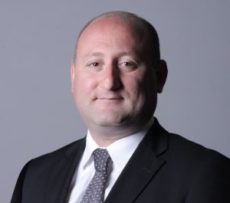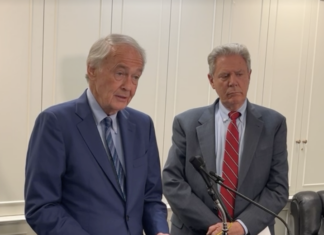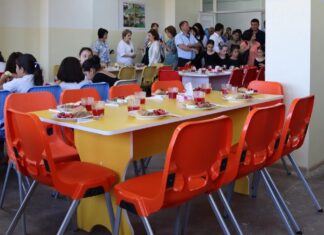LINCOLN, Neb. — On the occasion of the centennial of the Armenian Genocide, on March 19-20, the University of Nebraska-Lincoln (UNL) hosted a two-day conference titled, “Crossing the Centennial: The Historiography of the Armenian Genocide Re-Evaluated,” at the Wick Alumni Center. Organized by Prof. Bedross Der Matossian from UNL’s Department of History, the conference was sponsored by the Norman and Bernice Harris Center for Judaic Studies, the National Association for Armenian Studies and Research (NAASR), the Society for Armenian Studies (SAS), the Department of History, the Faculty Senate Convocation Committee, the Human Rights and Humanitarian Affairs Program, the Women’s and Gender Studies Program and the Institute of Ethnic Studies at UNL.
The conference focused on four under-researched themes that have recently gained scholarly attention: humanitarianism and humanitarian intervention in the Armenian Genocide; women and children in the Armenian Genocide; comparative dimensions of the Armenian Genocide; and the impact of the Armenian Genocide on society, politics, literature, and culture.
Seventeen scholars from Armenia, Cambodia, Canada, Holland, Hungary, Israel and the United States participated in the conference.
On March 19, the Chair of the History Department, Prof. William G. Thomas III, offered welcoming remarks in which he emphasized the commitment of the History Department to teaching and research of the field of Holocaust and Genocide studies. Der Matossian then made opening remarks in which he gave a brief background about the Armenian Genocide and highlighted the importance of commemorating the centennial in the academic sphere. In his remarks Der Matossian criticized the latest trend of denialism surging in the academic sphere: “Despite the fact that over the course of the past two decades, the historiography of the Armenian Genocide has evolved through the introduction of new methodologies, approaches and more complex analyses of the Genocide that venture beyond rudimentary and essentialist arguments and representations, denial of the Armenian Genocide has also gained new ground by using the academic sphere.” He argued that in comparison to scholarship on the Holocaust, denial of the Armenian Genocide is the one area which is more developed in the Armenian case.
Following Der Matossian’s remarks, the first panel, “Humanitarian Intervention and Humanitarianism,’ began. Chaired by Prof. David Forsythe from UNL, it featured three papers. The first paper, entitled “Humanitarian Intervention and Ottoman Opposition to Extermination: A Neglected Aspect,” was delivered by Dr. Hilmar Kaiser (Cambodia). Kaiser detailed the unique situation of the Ottoman Fourth Army in the Armenian Genocide and the role of Djemal Pasha, as the area under their control saw a significantly lower death toll than other regions of Empire. By 1918, relief workers, consular staff, and Ottoman oppositional circles had kept alive the majority of Armenian survivors within the empire argued Kaiser. According to him, notions of a unified Ottoman administration or CUP are obsolete. He suggested that a better understanding is needed to distinguish between CUP factions advocating repressive or genocidal policies. Kaiser’s paper was based on latest findings from the Ottoman archives, and western archives while focusing on the period before the Der Zor massacres. The next paper, entitled “Armenian Refugees, Humanitarian Assistance and Hungary,” was delivered by Péter Pál Kránitz (Pázmány Péter Catholic University). In his paper Kránitz demonstrated how the Hungarian government took part in the process of the international protection and support of the Armenian refugees of the Armenian Genocide within the framework of the League of Nations and by its internal jurisdiction. He discussed how Hungarian diplomacy committed itself to improving the efficiency of the Nansen passport system defining the quantity and the situation of Russian and Armenian refugees, and facilitating the transportation and integration of the refugees. Following Kranitz, Prof. Mark Toufayan (University of Ottawa) gave the last paper of the first panel. Entitled “Between Intimacy and Alienation: Armenian Property, Denationalization and the Passions of ‘Protection’ in French Mandated Cilicia, 1918-1923,” Toufayan’s paper discussed from a legal perspective the ambivalent relationship between French humanitarian efforts and the country’s economic interests. He argued that “far from resisting a form of economic imperialism, a politics of compassion and care for Armenian suffering in the aftermath of genocide was, in fact, central to population policies in the Near East by harnessing them to the political economy of European capitalism. At the same time, humanitarian discourse could be mobilized to reinforce economic inequalities between and amongst Armenians, French and Turks on either side of the debates about the legality of the confiscations, thus entrenching, rather than opposing, colonialist and nationalist bourgeois utopian state-building projects.”
The second panel was moderated by Prof. Jean Cahan, the director of the Harris Center for Judaic Studies, and included three speakers: Prof. Richard G. Hovannisian (University of California-Los Angeles) gave a passionate and a powerful talk titled “The Centenary of the Armenian Genocide: What Have We Learned?” Hovannisian recounted his family history and the way in which he encountered the Armenian Genocide. He focused on his experience of growing up with Genocide survivors and discussed the developments that have taken place in the field of the Armenian Genocide studies. While mentioning the positive developments, he concentrated on denial of the Armenian Genocide. “In the past I used to believe that denial was the last stage of genocide. Now I believe that denial is the first stage of genocide,” emphasized Hovannisian.








